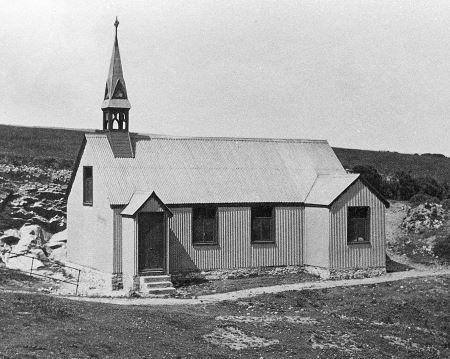History 1836-1925 – the Heaven era
 In 1836 William Hudson Heaven, of Bristol, bought Lundy with the intention that it would be a summer resort for his family, where he would be able to enjoy the shooting. Heaven was the son of a gentleman and he went to Harrow and Oxford. He was a well-travelled man who inherited estates in Jamaica and became a Freeman of the City of Bristol. When he bought Lundy, it was essentially a farm with a lighthouse and a castle. There was no church, no school, no doctor, no shop, no meeting room.
In 1836 William Hudson Heaven, of Bristol, bought Lundy with the intention that it would be a summer resort for his family, where he would be able to enjoy the shooting. Heaven was the son of a gentleman and he went to Harrow and Oxford. He was a well-travelled man who inherited estates in Jamaica and became a Freeman of the City of Bristol. When he bought Lundy, it was essentially a farm with a lighthouse and a castle. There was no church, no school, no doctor, no shop, no meeting room.
No owner of Lundy has ever really been able to make it pay. William Hudson Heaven was a gentleman and lived the life of a gentleman, and that cost money. Fortunately for him, he had money – some of it from the compensation paid by the government to owners of slave plantations when slavery was abolished in 1834. But Lundy demanded money spent on it, not least for major improvements to the Beach Road to get carriages up it, and for a suitable gentleman's residence - 'The Villa' (later renamed Millcombe House). So in 1863, a lease was granted to the Lundy Granite Company and they started to excavate extensive quarries along the east coast. They built major engineering works and exported granite to the mainland – though it wasn't used in the Thames Embankment as they claimed and as some Lundy histories have repeated. The Granite Company's heyday was a short five years - the directors were crooks and the company went bust.
 Reverend Hudson Grosett Heaven was the eldest son of William Hudson Heaven and was educated at Oxford. He took holy orders and came to teach on Lundy in 1863, where he became the minister of the island. He inherited Lundy on the death of his father in 1883 and realised his ambition to build a church on the island. First he built an iron church which was then replaced by the present church of St Helen in 1897. It was consecrated by the Bishop of Exeter who had a rough crossing to reach Lundy. He said that he had no difficulty in believing in the doctrine of Purgatory after what he had experienced to reach the Kingdom of Heaven. Reverend Heaven also built a Sunday School which was converted by subsequent owners for accommodation and extended by the Landmark Trust – it's now known as the 'Blue Bung'.
Reverend Hudson Grosett Heaven was the eldest son of William Hudson Heaven and was educated at Oxford. He took holy orders and came to teach on Lundy in 1863, where he became the minister of the island. He inherited Lundy on the death of his father in 1883 and realised his ambition to build a church on the island. First he built an iron church which was then replaced by the present church of St Helen in 1897. It was consecrated by the Bishop of Exeter who had a rough crossing to reach Lundy. He said that he had no difficulty in believing in the doctrine of Purgatory after what he had experienced to reach the Kingdom of Heaven. Reverend Heaven also built a Sunday School which was converted by subsequent owners for accommodation and extended by the Landmark Trust – it's now known as the 'Blue Bung'.
An interesting series of photographs from this period, taken by J S Catford of Ilfracombe, can be viewed here.
 In 1906, the outside world came to Lundy with a bump. HMS Montagu was one of the Royal Navy's latest battleships and was undertaking trials in the Bristol Channel of Marconi's recently developed wireless. It was foggy, though the captain and navigating officer were sure they were off Hartland Point. As they proceeded slowly, they crashed into the south-west corner of the island, near Shutter Point. Some of the officers got ashore and walked north until they came to the North Light, where they explained to the keepers what had happened and said that they were pleased to have reached Hartland Point lighthouse. When the keeper said that they were at Lundy North, the Montagu officers didn't believe him. The keeper assured them firmly that he did know which light he was in charge of. That exchange didn't go down very well at the subsequent Court Martial. Initial attempts to refloat the Montagu didn't work, and she became a tourist attraction – many postcards were produced. The Admiralty concentrated on salvaging the valuable guns, and an aerial walkway was built from the island to the wreck to get off what they could. The rest was left to rot.
In 1906, the outside world came to Lundy with a bump. HMS Montagu was one of the Royal Navy's latest battleships and was undertaking trials in the Bristol Channel of Marconi's recently developed wireless. It was foggy, though the captain and navigating officer were sure they were off Hartland Point. As they proceeded slowly, they crashed into the south-west corner of the island, near Shutter Point. Some of the officers got ashore and walked north until they came to the North Light, where they explained to the keepers what had happened and said that they were pleased to have reached Hartland Point lighthouse. When the keeper said that they were at Lundy North, the Montagu officers didn't believe him. The keeper assured them firmly that he did know which light he was in charge of. That exchange didn't go down very well at the subsequent Court Martial. Initial attempts to refloat the Montagu didn't work, and she became a tourist attraction – many postcards were produced. The Admiralty concentrated on salvaging the valuable guns, and an aerial walkway was built from the island to the wreck to get off what they could. The rest was left to rot.
The Reverend Heaven died in 1916 and his nephew inherited Lundy, but he sold it in 1917 to a North Devon estate owner named Augustus Langham Christie. Christie took a professional approach to this small part of his land holdings and made many improvements. However, bad health compelled the family to sell in 1925 to Martin Coles Harman. The next major steps to the Lundy of today were about to be taken.
Text by André Coutanche
